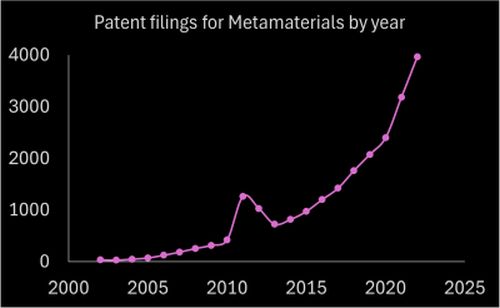Metamaterials are artificial materials that have been engineered to exhibit properties that do not occur naturally in their material constituents. Their properties come from engineered features such as the geometry, shape, size or arrangement the material. Every metamaterial is made up of engineered meta-atoms, whose collective effect is to provide these enhanced properties.
Metamaterials inherently push materials properties to the next frontier. They have huge potential in many areas of technology, and it is unsurpising that innovation in this field is gathering pace. Like all areas of innovation, there is potential for patent protection for new ideas. In fact, because of the nature of these inventions, innovation in this particular field can be particularly appropriate for patent protection. These materials rely on a synergistic combination of underlying chemistry and physical structure, and new metamaterials inherently require creative new combintations. Synergistic effects like this are recognised by patent offices a solid foundation for inventiveness, and there is an inherent creativity behind the design of a new metamaterial. If you have developed a metamaterial based on a new synergistic combination, there is a very good chance it will be a patentable invention.
Where innovation leads, patent filings follow, and a spike in patent filings for metamaterials was first seen in 2011, with over 1000 patent filings that year. Although filings ebbed away slightly in the following few years, since 2014, filings of metamaterials patents have increased nearly five-fold, and in 2022 nearly 4000 patent applications were filed that mentioned metamaterials.*

The patent filings span a huge range of technological fields showcasing the many possible applications of metmaterials: while telecommunications is the largest technical area, many patents also appear in fields such as optics, measurement, digital communications, medtech, AV technology and textiles. The word cloud below shows the top 20 technology areas for metamaterials patents:

The unique properties and wide range of applications make metamaterials ripe for commercialisation and industrial exploitation, and they may even be key to unlocking some of the world's biggest technological challenges. Solid patent protection will be essential for anyone looking to get the most out of their hard-earned innovation in this area.
If you are innovating in metamaterials, and haven't already sought IP advice, we highly recommend talk to a patent attorney sooner rather than later about your inventions. They will be able to advise you on what might be patentable, whether it makes sense for you to seek patent protection, and how to go about it. Importantly, they will also be able to advise you on what can and can't safely be disclosed (for example in articles and presentations) if you want to seek patent protection, because it is critical that any patent application is filed before the invention is disclosed.
Another reason to get early advice is to give yourself plenty of time to gather what you need for a strong patent application. In the area of materials science, data is likely to be very important in your patent applications, and the data that is needed for a patent application might not match the data you would usually put together for publications, funding applications or investment bids. If you have an early picture of what you might need to support a patent application, you will be able to build this into your research programme with plenty of time!
The content of this article is intended to provide a general guide to the subject matter. Specialist advice should be sought about your specific circumstances.


